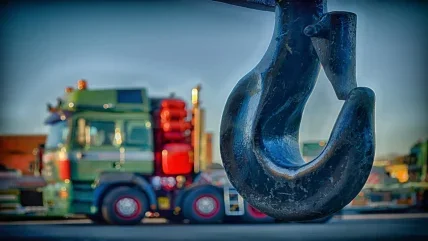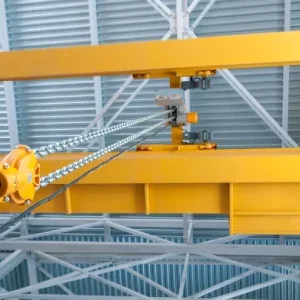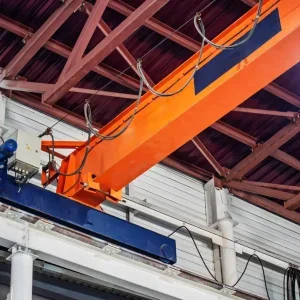
Despite historically unprecedented headwinds, the American hoist market is holding steady. While some in the industry report a larger-than-expected retraction in the wake of Covid-19, others say that business has picked up. Thomas Christensen is the VP of design for Syclone Attco Service, a manufacturer in Letha, Idaho. Christensen says that when the pandemic began, Syclone Attco expected a significant slowdown that never materialised.
“Business has slowed down, but not as dramatically as we expected,” Christensen says. “We’re getting a lot of interest internationally. About 90% of our buyers are working from home closing projects, so it’s been lucrative. At the beginning [of the pandemic] everyone put their funds on hold, but the doors are opening back up. We’re almost back to business as usual.”
Christensen says the pandemic has alerted Syclone Attco to resources and marketing methods that they weren’t previously leveraging, such as demonstration videos, content marketing, and influencer partnerships:
“We said for years that we were going to do more video, and we’ve been taking a lot of videos lately. We’ve been working with some YouTubers, and we’ve seen phenomenal interest from that.”
Custom projects have been a significant part of Syclone Attco’s success, especially those that focus on ergonomics. Christensen points to a recent project involving a machine shop in the boating industry that needed an industrial lift for large tools as an example.
“They have a few hundred machines that are all very similar,” he says. “They needed to lift tools out of the magazine. Leaning into a machine and pulling out an 80-pound tool is very unsafe. So we created an underhook device with a claw to grab the tool.”
The device in question was a modified version of Syclone Attco’s stock A9770 Sky Hook with mobile cart base and articulating arm. The lifting device itself, Christensen notes, was a stock product, while the underhook device and claw were both custom made-to-order fabrications.
CAPITAL PROJECTS ARE DOWN, BUT SMART TECH GROWS
Covid-19 has taken its toll on several American companies. Jim Vandegrift, president of R&M Materials Handling in Springfield, Ohio, says the pandemic has prompted a significant retraction. The market for hoist products, he says, has seen a 10–20% drop depending on product category—which is about twice the size of the retraction R&M was expecting. While some sectors like general manufacturing are holding somewhat steady, other sectors like oil & gas have significantly reduced demand for projects.
“Capital projects have dried up over the last three or four months,” Vandegrift says. “We’re hoping for a recovery in the third quarter, but we’ll wait and see. I don’t think anybody was expecting the rate of new Covid-19 cases and hospitalisations that we saw in June.”
While capital projects have suffered, companies are continuing to invest in safety technology and preventative maintenance. R&M recently introduced a new remote monitoring device, OLI, a smartphone app that wirelessly retrieves real-time data from R&M’s HoistMonitor unit. Vandegrift says that R&M rolled out the first iteration of OLI in January, and future updates will offer more advanced features to prolong equipment lifespan.
Says Vandegrift: “Sales are picking up, and we’re getting great feedback on it. Right now it only monitors the hoist, but as it’s developed, we’ll be able to get information out of the variablefrequency drive(s) as well as for the crane components.”
OLI and the HoistMonitor can be installed on a new hoist or retrofitted onto an existing piece of equipment. Every piece of equipment has a unique identification number in the OLI app, making it possible to easily monitor several pieces of equipment at once. Vandegrift says that OLI offers significant advantages to maintenance workers and clients. “(It used to be the case that) if a customer calls and a hoist isn’t operating properly, we send out a serviceman who drives an hour, climbs up the hoist to get to the monitoring unit, and then realises he doesn’t have what he needs on the truck. So then he has to drive an hour back and possibly come back the next day. With OLI, we can pull the information directly from the hoist and make sure the service technician is prepared when he shows up.”
Bret Lussow, director of business development at Handling Systems International (HSI) in McCook, Illinois, says ergonomic trends in hoist design are continuing to grow. Lussow says that HSI launched a workstation crane 18 months ago that has performed well.
“It’s amazing how many inquiries we’re getting from people who are trying to lift 50 to 100 pounds,” Lussow says. “Ten years ago, they wouldn’t have blinked an eye at just having someone pick up the product and move it. But now, there’s a lot of interest in ergonomics and safety. It’s creating new opportunities in the 2-ton and under capacity, which represents 80% of the market by volume.”
Lussow says that hoist technology is becoming more affordable as it advances, and the market is transitioning from being price-driven to being application-driven. HSI is the exclusive American manufacturer of Greek manufacturer Helm Hellas SA’s new NikoRail line of 4,400-pound capacity enclosed-track cranes.
Another technology innovation HSI has implemented is changing their quote and design process: “Just this week, we launched an online quote tool, trademarked Quotinator, that any dealer can access. Dealers can get instant 3D CAD and PDF drawings through SolidWorks. We also use a bolt-on software called DriveWorks, and they recently did a case study on us because of this quote tool we’ve developed.”
ELECTRIC AND HYDRAULIC HOISTS GO CUSTOM
Custom hoist installations are growing, with bespoke solutions emerging for various private sector and public sector projects. Mark Koski, North American commercial leader for Ingersoll Rand, headquartered in Davidson, North Carolina, says that Ingersoll Rand’s work in the marine and aerospace sectors often involves highly customised equipment.
“We’ve built custom hydraulic hoists for the United States Navy that are designed for underwater use,” Koski says. “Military projects are very active right now. We’ve also done work for space agencies and private-sector space applications, and that arm of our operations has been growing.”
Ingersoll Rand launched a new subsea hydraulic hoist at the end of 2019 in response. The maritime industry, Koski says, typically uses air hoists that require frequent disassembly and cleaning in order to prevent saltwater corrosion. Ingersoll Rand’s new subsea hoist, though, is entirely hydraulic and features a sealed gearbox, which reduces maintenance.
“Everything is sealed,” Koski explains. “You run hydraulic fluid down to the hoist and return it to the surface back to the hydraulic power unit. When you’re done using the hoist and you bring it back to the surface, you can rinse it with fresh water, spray it with WD-40, and it’s ready for its next use.”
This new subsea hoist began as an engineered-to-order special project for the United States Navy. Upon completion of the project, Ingersoll Rand asked for and received the navy’s permission to sell the hoist commercially.
Koski says that across Ingersoll Rand’s Industrial Lifting Equipment and High- Capacity Hoists & Winches business units, there is a growing trend for custom electric work. Ingersoll Rand is now expanding its ELK Electric hoist line to offer larger hoists that can handle heavier loads. Many of these heavy-duty hoists are highly customised for specific end-use applications that demand more robust safety features.
“We used to only manufacture the ELK line for up to 1-ton loads, and now we’re making it for up to 5-ton loads,” Koski notes. “These hoists come standard as two-speed and are available as variable drive, high speed, and explosion-proof units. It’s not just run-of-the-mill stuff. The new ELK line is engineered for tough environments.”
Ingersoll Rand, Koski says, has seen a slowdown in more standard stock orders since the start of the pandemic. However, this slowdown has been offset by a significant increase in demand for special projects. Koski says that Ingersoll Rand is embracing this change and adapting its company culture to accommodate more special projects.
THE PUSH TO REMOTE AND AUTOMATED EQUIPMENT
As hoist technology continues to get smarter, remote and automated equipment is growing. Steve Vitello, executive director of sales and marketing for Columbus McKinnon Corporation’s North American Hoists & Rigging division, and Dan Beilfuss, director of sales, Americas, for CMCO’s Crane Solutions Group, both based in Getzville, New York, say that a push to boost productivity and improve safety is driving innovation in automated and remote equipment. They note that the Covid-19 pandemic is also creating a sense of urgency around automation. Automated technology and remote diagnostics tools allow for greater social distancing, they say, which makes for a safer workplace.
Columbus McKinnon recently launched two products designed to make automation and remote operation safer and more effective. The Magnetek Intelli-Lift allows for wired or wireless hoist operation and automatically detects load misalignment and snags. Intelli-Lift offers both personal computer and smartphone/tablet software, and can work as a retrofit installation with compatible hoists.
Said Columbus McKinnon in a recent press release: “Intelli-Lift alerts operators with a visible and audible warning before a dangerous load misalignment or snag condition occurs. Using sensors and a status control enclosure, the system activates directional lights and a programmable warning horn if it detects a side pull or off-centre pick. Intelli-Lift will then assist operators, through manual or automatic adjustment, to centre the bridge and trolley over the load before it is hoisted.”
Meanwhile, Magnetek Intelli-Protect is a pre-packaged no-fly-zone system that prevents hoists from running into obstacles. Intelli-Protect was designed for the automotive, manufacturing, steel, and pulp and paper industries, and enables operators to designate specific areas where a crane will stop or slow down. Like Intelli- Lift, Intelli-Protect can be controlled via Wi-Fi with a smartphone, tablet, laptop, or desktop computer.
Vitello and Beilfuss said in a joint written statement that during the pandemic, only essential businesses were investing in hoist equipment, and repairs are more common than new installations. Now, though, with more American states opening up and returning to work, demand is starting to grow. Columbus McKinnon, they say, is adjusting to a post-pandemic world of work by changing how they conduct business. Webinars are replacing in-person training, and aftermarket technical support is increasingly taking place by video.
DEMAND GROWS FOR PORTABILITY & MANOEUVRABILITY
Portable equipment is quickly becoming popular in a variety of end-use sectors. Gloria Gibson, senior marketing coordinator for Winona, Minnesota-based Thern, says that more organisations are seeking out the versatility offered by portable hoists and hand winches like Thern’s Liberty series of capstan winches.
“We’ve seen it used in elevators, with wind turbines, and even for tree removal,” Gibson says. “Portability is in demand right now—people want to be able to use their winches in various places.”
Manoeuvrability is also a growing priority for Thern’s customer base. In August 2020, Thern released an update to its Liberty capstan series of winches. The updated model, Gibson says, includes a swivel frame to allow for a greater range of movement and a hitch mount that can be attached to the back of a truck.
Gibson says that the updated Liberty capstan series also offers advanced safety features designed for use in the elevator and energy industries: “With our capstan winches, the foot switch has to be down for the drum to rotate. That feature comes standard. A lot of other winches of this type will only have a switch like that as an optional add-on.”
Gibson says that Thern has seen an increase in civil and heavy engineering applications in recent years. Thern is seeing growing demand for pump hoists and electric winches for wastewater applications, as well as demand from the energy and marine sectors.
“We also have Thern Stage, which is our entertainment sector division. We saw a big increase there before the pandemic, and it’s starting to come back now. Historic stages getting new rigging equipment, new stadiums being built, things like that.”
The theatre industry’s needs are driving new technological innovation. As hoists become more intelligent, Gibson says that hoist technology is moving beyond merely tracking data about overheating or maintenance issues. Hoists are smarter now than ever before, she says, and many pieces of equipment involved in theatre productions can now talk to each other. One machine can, for instance, order another machine to switch off in the event of an emergency.
Thern’s Commander 2000 series portable Davit cranes were most recently used at NASA’s John C. Stennis Space Center in Mississippi, the largest rocket engine testing facility in the United States. NASA is currently testing rockets for the Artemis Program there. The Artemis Program aims to put the first woman and the next man on the moon by 2024.
GOVERNMENT POLICIES: A MIXED BAG
While the American hoist industry has benefitted from some of the Trump Administration’s policies, it has also suffered as a result of other policies. Koski says that the American government’s recent military expansion has been beneficial for Ingersoll Rand. “The expansion and investment in the military has had a positive impact on our revenue,” Koski notes.
Vandegrift says that the Trump administration’s tax cuts have grown industry, and deregulation has made it easier for companies to operate. Meanwhile, Christensen notes that the Trump tariffs have had a small but negative impact on Syclone Attco’s operations: “Over the last three and a half years, we’ve had to deal with the effects of more tariffs and import restrictions. We’ve had to do a price increase. But ultimately, being a USA-made product, we held strong. The economy was strong, and we’ve been able to expand.”
Some in the industry say that a Trump presidency is a mixed bag, but also worry that a change in government might have adverse effects. According to Lussow, the looming election is creating uncertainty. “Election years are always a wildcard,” he says. “People hold their money a little tighter the closer we get to the election. I think, in general, some of President Trump’s policies have helped American manufacturing, whereas some of his other policies have hurt manufacturing.” Lussow says that overall, American manufacturers have generally done well during President Trump’s tenure. Now, the prospect of a different administration is creating uncertainty: “What happens if there’s a change in government? Do some of the tariffs go back in place? What happens to interest rates? Money is almost free right now.”
THE NEW NORMAL OF A POSTPANDEMIC ECONOMY
Lussow says that he expects the health of the American hoist market to hinge on the development of a safe and effective vaccine for SARS-CoV-2, the virus that causes Covid-19. If a vaccine enters widespread rollout relatively soon, a recovery looks likely.
Dr. Anthony Fauci, director of the National Institute of Allergy and Infectious Diseases and an advisor on the White House Coronavirus Task Force, told a House of Representatives committee on the 23rd of June that the development of a vaccine is a matter “of when, not if,” and that he is cautiously optimistic that a vaccine will be ready for mass production by late 2020 or early 2021.
Until then, the American hoist market will need to adjust to its new normal of more stringent safety measures, higher costs, working from home when possible, and using more digital marketing tactics like video in place of in-person sales and marketing






